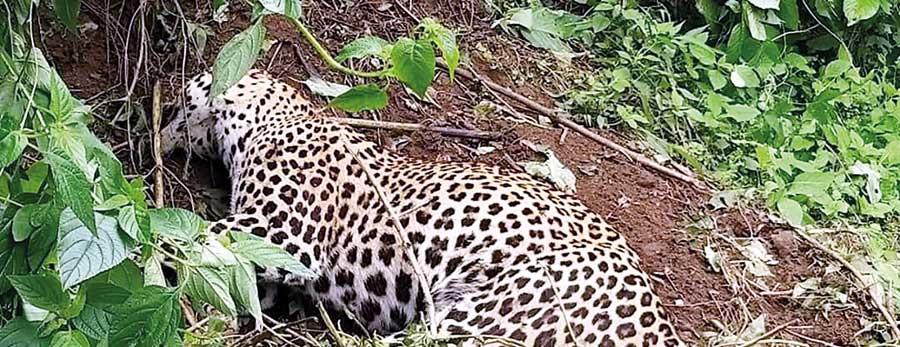26 Jun 2020 - {{hitsCtrl.values.hits}}
More leopards killed in deadly snares

Mother-leopard killed in Pussellawa
So far this year, six leopards in Sri Lanka have been killed due to human activities. And the count would certainly rise if authorities continue to ignore the gravity of the situation. According to wildlife conservationists, leopards frequent areas like Maskeliya, Ginigathhena, Hatton, Norwood, Bogawanthalawa and Lakshapana. However, these habitats have become threats to leopards with continued snaring. Just a day after the mother leopard in Pussellawa was killed from snaring, a photo of a dog trapped in a snare in an estate near Horton Plains went viral on social media. This technique, referred to as‘pani mula danawa’in Sinhala, is an age-old practice to trap leopards. Leopards that are killed are sold for meat, while their teeth and claws are sold at exorbitant rates. 
Commenting on the black leopard death, environmentalist Nayanaka Ranwella said he was unhappy with how the Department of Wildlife Conservation (DWC) had handled the situation. “They took around 6-8 hours to reach the location. By that time the damage was done. They weren’t aware of proper rescue techniques. In the videos you would see them dragging the leopard from its tail. And the pliers they used weren’t sharp enough to cut through the noose. They weren’t wearing gloves, and we know during this pandemic any wound, whether human or animal, should be treated with maximum precautions. The animal was transported a long distance, and that too in an ad hoc manner. Poor quality transportation would have caused capture myopathy, leading to its death. It is surprising officials don’t seem to understand this yet,” Ranwella said.
“Another shortcoming was the absence of a veterinary unit in the area. So the leopard had to be transported all the way to the Udawalawe Elephant Transit Home. Once there, there was no weighing scale for the wounded animal. So it may have been administered medical doses without checking its weight. When hormones are released due to stress, an animal will eventually die. The DWC doesn’t have proper safety equipment for rescues. They don’t have helmets, protective gear, trolleys for animals and other equipment. We also saw how villagers, photographers and other inexperienced people gathered around the leopard.”
Ranwella added the DWC needed an intelligence unit to investigate the two metals used to make snares. “If they detected how these metals were brought into the country they could trace the offenders. Also, with an intelligence unit they can send teams on raids. But we don’t see them making such attempts. On the other hand, estate owners should also be held responsible for the laying of snares.”
He warned if this continued they would have to expose these bloody realities to countries that bought tea from these estates. “At least when their shares and markets go down, they will give more attention to this wildlife disaster.”
"DWC needs an intelligence unit to investigate the two metals used to make snares"
|
'Pani mula danawa' - Age old practice to trap leopards still seen today (Pic : J. Gallage) |
Refuting the allegations, DWC Director General M.G.C Sooriyabandara said estate communities had been educated of the dangers of laying snares. “But we haven’t directly spoken to estate owners. Before arresting someone we need evidence. Sometimes these snares are laid without the knowledge of estate owners. The DWC has powers to file cases in the Magistrate’s Court or District Court.”
Responding to why officials didn’t use gloves to rescue the black leopard, Sooriyabandara said it was an emergency situation and it was difficult to wear gloves in such a situation.
He revealed the DWC receive around 150-200 calls daily on various wildlife crimes. However there was no mechanism to deploy teams as and when a crime was reported, he said. “I don’t think any institution would be able to do that. But we have the staff and necessary equipment for a rescue operation.”
When asked if technology like camera trapping, radio-collaring or micro-chipping could be done on leopards, he said it was not an easy task. “It’s very difficult to tranquilise a leopard and put a collar while a camera-trapping which is an artificial method. We need to identify their habitat locations. But there are other techniques we could use to study leopard behaviour.”
According to the Flora and Fauna Protection Ordinance (FFPO) Section 30, the use of traps, snares or other instruments to kill, wound or take any wild animal is prohibited outside a National Reserve or Sanctuary. Apart from that, Section 30 (1) states any person who uses traps, snares or other instruments to kill, wound or take any wild animal (in Schedule I) outside a National Reserve or Sanctuary is guilty of an offense, and liable to be fined between Rs 20,000 - 50,000 or face imprisonment from 2-5 years.
“The FFPO is an old law and is very relaxed in these matters,” opined lawyer Anura Meddegoda (PC). “Since January 2019, every two weeks a leopard has been killed. We are now trying to create awareness among politicians. But they are not interested because leopards or elephants don’t vote. Leopards are part of our national heritage, and we cannot allow people to kill them in this manner.”
Meddegoda is fighting the black leopard’s case pro-bono, while heading the legal team at Justice for Animals, a non-profit animal welfare charity headed by Ven. Omalpe Sobitha Thera. “If we don’t take drastic action, leopards will soon become extinct in Sri Lanka. There is a need for more stringent laws with stricter fines and prison terms.”
He added there is a high demand for leopard meat among Chinese, as they considered the meat above the leopard’s shoulder to be an aphrodisiac. “With Chinese coming into the country, this could be a way in which local communities are earning some extra money. Also during the curfews, people began setting up vegetable plots. They began clearing the land and routes where leopards used to roam. But these cultivations are destroyed by wild boar and other livestock, and when leopards go after this livestock they get trapped in the snares.”
"There is a high demand for leopard meat among Chinese, as they considered the meat above the leopard’s shoulder to be an aphrodisiac"
“We are trying to discourage people from laying snares,” an estate owner in Maskeliya who wished to remain anonymous said. “It is illegal to lay snares. But they continue to do it to protect their crops. People are clearing land and putting up vegetation, especially after the pandemic. Once they put up these plots, they lay snares to trap small animals. But eventually leopards also get caught.”
He added although the DWC had a bigger role to play in controlling this issue, they hardly went on inspections. “They haven’t visited our estate to check snares. But whenever I get news I inform my staff to remove them. So, a little monitoring, or allowing estate managements to intervene, would help resolve this issue.”
Wildlife conservationist Sethil Muhandiram has been vocal about leopard conservation. After the death of the mother leopard in Pussellawa, he made many suggestions on how the DWC could take things forward. They are:
28 Nov 2024 1 hours ago
28 Nov 2024 1 hours ago
28 Nov 2024 2 hours ago
28 Nov 2024 3 hours ago
28 Nov 2024 6 hours ago